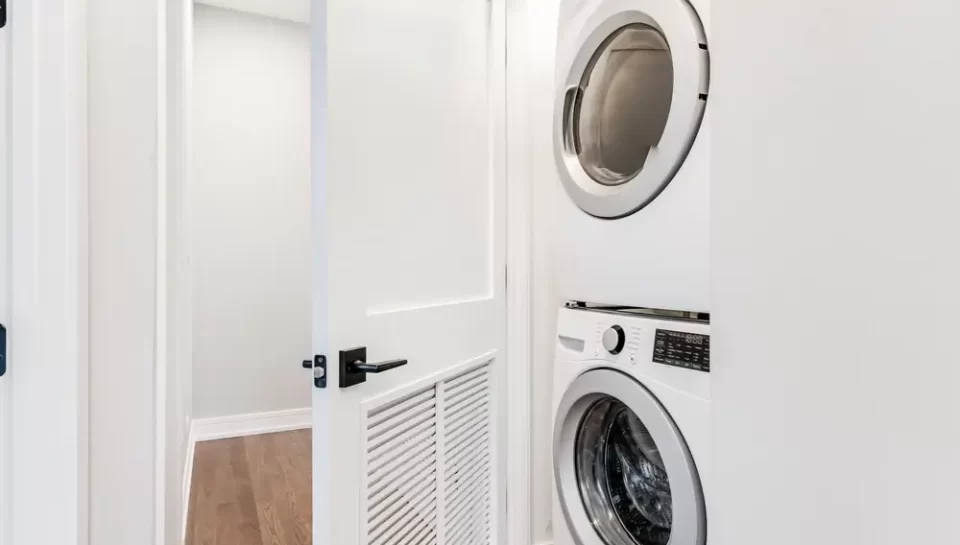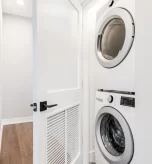Fitting a full laundry setup into a small space can be a challenge, but not an impossible one. If you have limited space or want to improve your home’s layout, a stackable washer and dryer can help.
Installing one in a closet is a smart way to save space. No matter if it’s in a hallway, kitchen nook, or master closet, the right setup can make things easier. You can do this without losing good design.
In this guide, we will look at practical and stylish ideas for washer and dryer closets. We will also share layout tips, size requirements, design tricks, and organisation hacks. These will help make your space both functional and attractive.
Why Choose a Closet for Stackable Washer and Dryer Units?
The biggest advantage of a closet for stackable washer and dryer appliances is maximising vertical space. Stacking the units frees up the floor area that side-by-side machines would otherwise occupy. Here are some key benefits:
- Space Efficiency: Ideal for apartments, townhomes, or smaller homes.
- Discreet Placement: Easily hidden behind washer and dryer closet doors.
- Increased Convenience: Place your washer and dryer closer to bedrooms or bathrooms for ease of access.
- Flexible Design: Can be incorporated into a walk-in closet, kitchen, or hallway without disrupting flow.
Read More: How to Fix a Squeaky Ceiling Fan Fast and Easy?
Closet Size for Stackable Washer and Dryer
Before jumping into design ideas, it’s important to understand the required space. Knowing the closet dimensions for a stackable washer and dryer helps prevent renovation headaches later.
Standard Closet Dimensions
- Width: Minimum 30 inches (each unit is usually 27 inches wide).
- Depth: Minimum 36 inches to accommodate venting and hoses.
- Height: At least 80 inches to fit stacked units and provide airflow.
- Door clearance: Allow 1–3 inches on each side of the appliance.
Keep in mind that closet size for stackable washer and dryer setups can vary by model. Always check the manufacturer’s specifications.
Creative Stackable Washer And Dryer Closet Ideas
1. Closet in the Hallway
A stacked washer and dryer is great for homes with little laundry space. You can place it in a closet along the hallway. Bi-fold or sliding doors can hide the washer and dryer. Add floating shelves above the units for storage without clutter.
2. Washer and Dryer in Master Closet
Turn your master closet with a washer and dryer into a private laundry retreat. Place the units on one wall and use the remaining space for clothes storage. Include a countertop above for folding, and ensure that you install proper ventilation.
3. Walk-In Closet with Washer and Dryer
Have a large walk-in wardrobe? Why not make room for a walk-in closet with a washer and dryer setup? This allows for one efficient space to handle wardrobe, washing, and folding tasks—perfect for busy households.
4. Tucked Under Stairs or in Pantry Closets
Get creative with underutilized areas. A washer and dryer in the closet under the stairs or within a deep pantry cabinet can work well in small homes. Use stackable models and closet doors that match your decor to keep it seamless.
5. Kitchen or Mudroom Nook
A closet with a washer and dryer near your entryway or kitchen is ideal for homes with kids or pets. Use barn-style sliding doors to keep the area stylish while hiding the machines when not in use.
Design Tips for a Functional Washer and Dryer Closet
Creating a washer and dryer closet that works involves more than just placing appliances in a tight space. Here are some design tips:
- Ventilation Is Key: Install proper ducting or a ventless dryer. Leave space behind units for airflow.
- Electrical and Plumbing Access: Ensure outlets, water lines, and drainage are easily accessible.
- Lighting: Add motion-sensor lights or LED strips for visibility in smaller spaces.
- Soundproofing: Insulate the walls or use acoustic panels if located near bedrooms or living areas.
- Flooring: Use waterproof flooring like tile or vinyl in case of leaks or spills.
Read More: Electrical Safety Inspection Guide for Homeowners
Organising Your Washer and Dryer Closet
Even the smallest laundry closets can be highly efficient with the right organisation:
- Wall-Mounted Racks: For detergents, dryer sheets, and stain removers.
- Pull-Out Hampers: Slide-out laundry baskets keep dirty clothes out of sight.
- Hooks and Hangers: Hang delicate clothes or cleaning tools.
- Folding Countertops: Install a drop-down or permanent surface for folding clothes.
Closet Door Options for Washer and Dryer Closets
Choosing the right doors for washer and dryer closet setups is both functional and aesthetic. Consider:
- Bi-Fold Doors: Space-saving and easy to open.
- Sliding Barn Doors: Add character and hide the machines completely.
- Louvered Doors: Offers ventilation while keeping things concealed.
- Pocket Doors: Slide into the wall—ideal for super tight spaces.
FAQs
1. What are the ideal dimensions for a washer and dryer closet?
Typically, you need at least 30″ width, 36″ depth, and 80″ height. Always confirm with your appliance’s specs.
2. Can I install a washer and dryer in my master closet?
Yes, a washer and dryer in the master closet setup is popular and practical. Just ensure there’s proper plumbing, electrical, and ventilation.
3. How do I ventilate a washer and dryer closet?
You will need a dryer vent or a ventless model. You may also need air gaps and a louvred door. These help keep airflow and reduce moisture buildup.
4. Is it safe to enclose a stacked washer and dryer in a closet?
Absolutely—just ensure adequate clearance, airflow, and access to water shut-off valves and outlets.
5. What’s the best door type for small washer and dryer closets?
Bi-fold or pocket doors are great space-saving options. Sliding barn doors are a stylish alternative for larger spaces.
Conclusion
Making a stackable washer and dryer closet is not just about saving space. It also adds function and style to your home. You can design a small hallway nook or a master closet with a washer and dryer. There are many creative ways to make the space fit your lifestyle.
Always check the size of the washer and dryer closet before starting your project. Don’t forget the small details, like doors, lighting, and ventilation. These details can make a significant difference in daily use. With the right setup, your laundry closet can be both hidden and hardworking.
For more home improvement ideas and property care insights, visit Key Property Inspection Group.





